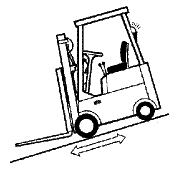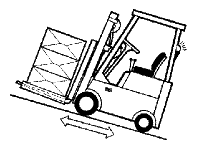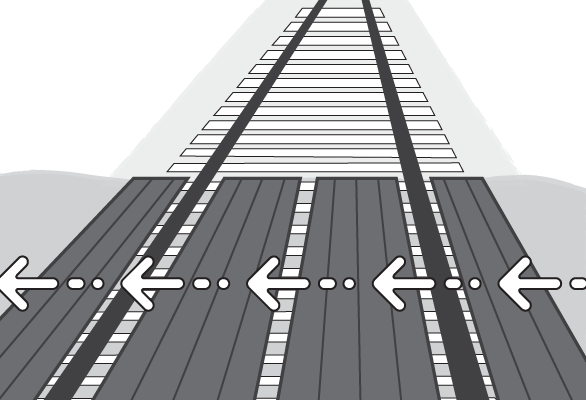Forklift Trucks - Loading and Unloading
On this page
- When should you load and unload materials using forklift trucks?
- How should you prepare the work area before using a forklift truck for the loading or unloading operation?
- What should you do while loading and unloading with a forklift truck?
- When using forklifts around railway tracks and loading railcars, what is important to know?
- What should you do when using a forklift truck in an elevator?
When should you load and unload materials using forklift trucks?
Back to topForklift trucks are very versatile. They can be used to move loads onto and off trailers, railcars, cargo vans, and pickup trucks. Certain loads may be unsafe to load or unload using a forklift (e.g., when loads are large or unbalanced). Always determine if a forklift is an appropriate method for material handling.
Please see the OSH Answers Forklift Trucks – Maintaining Truck Control for more information.
How should you prepare the work area before using a forklift truck for the loading or unloading operation?
Back to topFor example, when loading or unloading a transport trailer:
- Make sure that the transport vehicle's brakes are engaged.
- Ask the driver to turn off the vehicle’s motor to reduce exposure to exhaust fumes.
- Chock the vehicles' wheels.
- Engage a trailer restraint system, if available, as the restraint can help prevent the trailer from separating from the loading dock.
- If loading or unloading a flatbed trailer, make sure that it is parked on a level surface that is free of debris, depressions, mounds, and unstable ground.
- Instruct the vehicle’s driver to stay clear of the loading and unloading area while forklift is in motion.
- Make sure that the trailer’s landing gear or stabilizer is fully supporting the trailer if it is not coupled to a vehicle.
- Post signs warning not to move the vehicle.
- Check that there is sufficient clearance between the forklift (including the load when raised) and the trailer’s roof.
- Make sure the trailer’s deck can support the combined weight of the forklift and the load.
- Inspect the interior of the trailer for trash, loose objects and obstructions, holes or weak flooring, poor lighting, liquid spills, low overhead clearance, etc.
- Do not load or unload in adverse weather conditions.
- Choose the forklift with the most appropriate features for the conditions (e.g., enclosed cabin for cold weather, pneumatic tires for outdoor loading/unloading, onboard lights, etc.).
- Make sure that docks and dock plates are in good working condition, clear of obstructions, and not oily or wet.
- Make sure that the dock plate is properly positioned, levelled, secured, and can support the weight of the load and forklift before driving over it. The dock plate load weight should be clearly marked.
Make sure dock edges are clearly marked.
What should you do while loading and unloading with a forklift truck?
Back to top- Sound horn when entering and exiting trailers or bays.
- Be alert for other vehicles, pedestrians, and materials around you.
- Continuously evaluate the status of the trailer, dock plate, and forklift. Stop loading or unloading if conditions become unsafe (e.g., trailer tilts, gap forms between the trailer and the dock, forklift becomes difficult to steer, etc.).
- Evaluate each load before each lift. Do not lift unstable or unsuitable loads (e.g., leaning or improperly secured loads, loads sitting on damaged skids, etc.).
- Use the proper technique when loading and unloading to prevent tipping the trailer/vehicle (i.e., keep the load balanced on the trailer, railcar, etc.).
- Keep forks pointed downhill when travelling without a load on a ramp.
- Keep forks pointed uphill when travelling with a load on a ramp.


- Stay clear of edges of docks, rail cars or ramps.
- If the forklift is gas or propane powered, do not operate forklifts inside vehicles for long periods without ventilation.
- Drive slowly and carefully to avoid damaging the forklift or trailer, alter the alignment of the dock plate with the trailer, shift the weight distribution of the trailer enough to cause a tip over.
When using forklifts around railway tracks and loading railcars, what is important to know?
Back to top- Cross railway tracks on a diagonal at designated locations only.
- Make sure that handbrakes, wheel blocks and derailer are set before entering a railcar.
- Do not park a forklift within three meters of railway tracks or inside railcars.
- Do not tow or push railcars or trucks with a forklift.
- Do not open railway car doors with forklift forks .

What should you do when using a forklift truck in an elevator?
Back to top- Do not use a forklift truck in any elevator unless specifically authorized to do so.
- Before entering any elevator, make sure that the elevator is designed to carry a forklift, considering factors such as clearances, ventilation, and weight capacity (make sure that the weight of the forklift and load do not exceed the elevator capacity).
- Approach the elevator slowly, stop at a safe distance from the elevator gate. Enter squarely and slowly.
- Neutralize the forklift controls, apply the parking brakes, and shut off the forklift.
- Dismount the forklift before operating the elevator controls. Do not ride elevators that are not certified for passengers.
- Once the elevator has come to a complete stop at the desired floor, reverse the process to exit or unload the elevator.
- Fact sheet last revised: 2022-07-26
